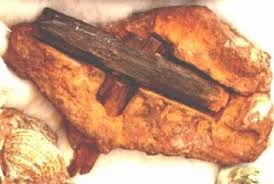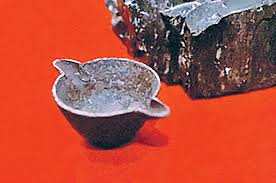Civilization May Be Much Older Than We Thought…Or Not : A Well Thought Out Scream by James Riordan

For years science and religious leaders have been arguing over the age of modern civilization. Biblical accounts place the time of Moses about five thousand years ago. Science pretty much agrees because the artifacts discovered from that period seem to be about that old. It’s the time before Moses where the differences arise — especially the time from Adam and Eve to Abraham. The truth is we just don’t know. The Bible says Adam was the first man, but does that mean the first of the species Homosapien or were Adam and Eve Neaderthals or some other form of prehistoric man. As Brad said to the Dude in the Big Lebowski, “Well, Dude. we just don’t know.”
There was the story of the Colorado rancher who found a lump of coal in the 1800’s and when it broke it open he discovered a “strange-looking iron thimble.” It was dug from a vein some 300 feet below the surface.
The Salzburg Cube is yet another ancient puzzle found by a worker named Reidl, in an Austrian foundry in 1885. Like the others, this man broke open a block of coal and found a metal cube embedded inside. Recent analysis established the object was of forged iron and obviously hand crafted. The coal it was found in was millions of years old.
Back in 1889 near Nampa, Idaho, workers boring an artesian well found a small figurine made of baked clay at a depth of 320 feet. The workers had to cut through fifteen feet of basalt lava and other levels of strata below that to get to that depth. That may not seem unusual except for the fact that the uppermost layer of lava was dated to at least 15 million years old!
It is currently accepted by science and geology that coal is a by-product of decaying vegetation. The vegetation becomes buried over time and is covered with sediment. That sediment eventually fossilises and becomes rock. This natural process of coal formation takes up to 400 million years to accomplish.
Anything that is found in lumps of coal or in coal seams during mining, had to have been placed or dropped into the vegetation before it was buried in sediment.
 In June 1936 Max Hahn and his wife Emma were on a walk beside a waterfall near to London, Texas, when they noticed a rock with wood protruding from its core. They decided to take the oddity home and later cracked it open with a hammer and a chisel. What they found within shocked the archaeological and scientific community. Embedded in the rock was what appeared to be some type of ancient man made hammer.
In June 1936 Max Hahn and his wife Emma were on a walk beside a waterfall near to London, Texas, when they noticed a rock with wood protruding from its core. They decided to take the oddity home and later cracked it open with a hammer and a chisel. What they found within shocked the archaeological and scientific community. Embedded in the rock was what appeared to be some type of ancient man made hammer.
A team of archaeologists analysed and dated it. The rock encasing the hammer was dated to more than 400 million years old. The hammer itself turned out to be more than 500 million years old. Additionally, a section of the wooden handle had begun the metamorphosis into coal. The hammer’s head, made of more than 96% iron, is far more pure than anything nature could have achieved without assistance from relatively modern smelting methods.
In 1944, as a ten year old boy, Newton Anderson, dropped a lump of coal in his basement and it broke in half as it hit the floor. What he discovered inside defies explanation based upon current scientific orthodoxy. Inside the coal was a hand crafted brass alloy bell with an iron clapper and sculptured handle.
When an analysis was carried out it was discovered that the bell was made from anunusual mix of metals, different from any known modern alloy production (including copper, zinc, tin, arsenic, iodine, and selenium).
metals, different from any known modern alloy production (including copper, zinc, tin, arsenic, iodine, and selenium).
The seam from whence this lump of coal was mined is estimated to be 300,000,000 years old!
These extraordinary discoveries although bizarre, are not unique or even uncommon. There are literally thousands of them collecting dust, locked away from public scrutiny in the vaults of museums throughout the world.
There are many other unusual reported finds including the following:
The Morrisonville, Illinois Times, on June 11, 1891, reported how Mrs. S. W. Culp found a circular shaped eight-carat gold chain, about 10 inches long, embedded in a lump of coal after she broke it apart to put in her scuttle. The chain was described as “antique” and of “quaint workmanship.”
Displayed in a museum at Glen Rose, Texas, is a cast iron pot reportedly found in a large lump of coal in 1912 by a worker feeding coal into the furnace of a power plant. When he split open the coal the worker said the pot fell out, leaving its impression in the coal.
 The list of such items goes on and on and on. There’s a name for such object – they’re called Ooparts, or Out of Place Artefacts. Ooparts are called this because conventional scientific wisdom (an oxymoron if ever there was one) states that these artefacts shouldn’t exist based upon currently accepted beliefs regarding our origins and history. These discoveries are “out of place” in the orthodox timeline of human history. The usual methods of the conformist scientific community, when faced with such anomalies is to attempt to debunk their reported age, or perhaps endeavour to discredit the source of the report or even the reporter. If this approach fails then usually the artefacts themselves are banished to the shadowy vaults of museums and warehouses, never to be seen again.
The list of such items goes on and on and on. There’s a name for such object – they’re called Ooparts, or Out of Place Artefacts. Ooparts are called this because conventional scientific wisdom (an oxymoron if ever there was one) states that these artefacts shouldn’t exist based upon currently accepted beliefs regarding our origins and history. These discoveries are “out of place” in the orthodox timeline of human history. The usual methods of the conformist scientific community, when faced with such anomalies is to attempt to debunk their reported age, or perhaps endeavour to discredit the source of the report or even the reporter. If this approach fails then usually the artefacts themselves are banished to the shadowy vaults of museums and warehouses, never to be seen again.
If these unusual artefacts were “one offs” then perhaps one could be forgiven for accepting the view espoused by the mainstream scientific and archaeological community that they are hoaxes or misreported stories. However, when one realises that thousands upon thousands of these anomalous artefacts have been discovered and reported over the years, then one may need to re-evaluate ones acceptance of the integrity of mainstream archaeology and science.
The problem the mainstream has with these anomalous Ooparts is that they throw into question every single established belief there is regarding our past.
It seems that everywhere we look, we find things that contradict much of the scientific orthodoxy of today. The scientific establishment will never acknowledge or admit that these artefacts are authentic. To do so would be to admit that they are completely wrong about our origins, and consequently, invalidate all of the text books used to indoctrinate us and our children.
The discovery of Ooparts completely annihilates the [comparatively recent]theory of evolution. If, as this hypothesis would have us believe, modern humans only evolved 200,000 years ago (or thereabouts), one has to ask how man made artefacts, found in substrata originating millions of years ago, could be explained?
There will no doubt be readers who, similar to predictable conservative archaeologists, and probably due to their indoctrinated belief system, will also dismiss the aforementioned Ooparts as hoaxes or forgeries. Perhaps they would like to consider and offer an explanation for the following.
It is an accepted belief that humans and dinosaurs did not co-exist. According to conventional academia, dinosaurs roamed the earth between 65 and 225 million years ago, whereas the earliest upright biped humanoid, homo erectus, only appeared about 1.8 million years ago.
 However, in 1968 a palaeontologist named Stan Taylor began excavations of fossilised dinosaur footprints, discovered in the bed of the Paluxy river near Glen Rose, Texas. What he unearthed shocked and dumbfounded the scientific community. Alongside the dinosaur tracks, in exactly the same cretaceous fossilised strata, were well preserved human footprints.
However, in 1968 a palaeontologist named Stan Taylor began excavations of fossilised dinosaur footprints, discovered in the bed of the Paluxy river near Glen Rose, Texas. What he unearthed shocked and dumbfounded the scientific community. Alongside the dinosaur tracks, in exactly the same cretaceous fossilised strata, were well preserved human footprints.
Since the initial discovery, hundreds more human footprints have been discovered and unearthed, both in Paluxy and in many other places around the globe. Either those hoaxers have unlimited time and budget – or someone is telling porkies!
Next one needs to consider another find discovered in 100 million year old cretaceous limestone. A fossilised human finger, which was found along with a childs tooth and human hair. This finger has been subjected to numerous scientific tests and analysis. Sectioning revealed the typical porous bone structure expected in a  human finger. Additionally a Cat-scan and MRI scan identified joints and traced tendons throughout the length of the fossil. This is one find that science cannot explain away as a hoax.
human finger. Additionally a Cat-scan and MRI scan identified joints and traced tendons throughout the length of the fossil. This is one find that science cannot explain away as a hoax.
There is however another find of recent years that blows all of the others into a cocked hat regarding age.
Over the past few decades, miners near the little town of Ottosdal in Western Transvaal, South Africa, have been digging up hundreds of mysterious metal spheres. These spheres measure between 25 and 100 mm in diameter, and some are etched with three parallel grooves running completely around the equator. Two types of spheres have been found. One is composed of a solid bluish metal with flecks of white, the other is hollowed out and filled with a spongy white substance.
 These spheres are reportedly so delicately balanced that even with modern technology, they would need to be made in a zero gravity environment to attain these characteristics. These objects have become known as the Klerksdorp spheres.
These spheres are reportedly so delicately balanced that even with modern technology, they would need to be made in a zero gravity environment to attain these characteristics. These objects have become known as the Klerksdorp spheres.
Geologists have attempted to debunk these artefacts as natural formations or “limonite concretions”. They fail to explain sufficiently how these formations occurred naturally with perfectly straight and perfectly spaced grooves around the centres.
Perhaps the real reason for such fervent attempted debunking by the scientific community, is that the rock in which these spheres where found is Precambrian – and dated to 2.8 billion years old!
Whether one wishes to accept these out of place artefacts as genuine or not is I suppose, down to personal beliefs. Everything we have been taught in our schools and universities about our origin and history, is based upon nothing more than speculation and hypothesis. There is not a single provable fact out there that conclusively answers the question “where do we come from”
The reality is that the origin of the human race is a total enigma. No one, anywhere, actually knows how old humanity is or how and where it originated. It is a complete mystery.





